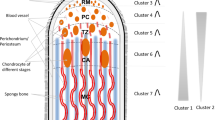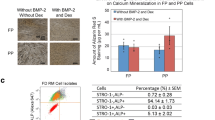Abstract
Annual re-growth of deer antler represents a unique example of complete organ regeneration. Because antler mesenchymal cells retain their embryonic capacity to develop into cartilage or bone, studying antler development provides a natural system to follow gene expression changes during mesenchymal differentiation toward chondrogenic/osteogenic lineage. To identify novel genes involved either in early events of mesenchymal cell specialization or in robust bone development, we have introduced a 3 K heterologous microarray set-up (deer cDNA versus mouse template). Fifteen genes were differentially expressed; genes for housekeeping, regulatory functions (components of different signaling pathways, including FGF, TGFβ, Wnt), and genes encoding members of the Polycomb group were represented. Expression dynamics for genes are visualized by an expression logo. The expression profile of the gene C21orf70 of unknown function is described along with the effects when over-expressed; furthermore the nuclear localization of the cognate protein is shown. In this report, we demonstrate the particular advantage of the velvet antler model in bone research for: (1) identification of mesenchymal and precartilaginous genes and (2) targeting genes upregulated in robust cartilage development.







Similar content being viewed by others
References
Aigner T (2002) Towards a new understanding and classification of chondrogenic neoplasias of the skeleton-biochemistry and cell biology of chondrosarcoma and its variants. Virchows Arch. 441:219–230
Allen SP, Maden M, Price JS (2002) A role for retinoic acid in regulating the regeneration of deer antlers. Dev Biol 251:409–423
Antonarakis SE, Lyle R, Dermitzakis ET, Reymond A, Deutsch S (2004) Chromosome 21 and down syndrome: from genomics to pathophysiology. Nat Rev Genet 5:725–738
Baksh D, Song L, Tuan RS (2004) Adult mesenchymal stem cells: characterization, differentiation, and application in cell and gene therapy. J Cell Mol Med 8:301–316
Banks JW, Newbry WJ (1983) In: Banks RD (ed) Antler development of cervidae. Cesar Kleburg Wildlife Research Institute, Kingsville, Texas, pp 279–306
Benetti R, Del Sal G, Monte M, Paroni G, Brancolini C, Schneider C (2001) The death substrate Gas2 binds m-calpain and increases susceptibility to p53 dependent apoptosis. EMBO J 20:2702–2714
Beppu H, Kawabata` M, Hamamoto T, Chytil A, Minowa O, Noda T, Miyazono K (2000) BMP type II receptor is required for gastrulation and early development of mouse embryos. Dev Biol 221:249–258
Corpet F (1988) Multiple sequence alignment with hierarchical clustering. Nucleic Acids Res 16:10881–10890
Epstein CJ (1995) In: Sly WS, Valle D (eds) The metabolic and molecular bases of inherited disease. McGraw-Hill, New York, pp 749–794
Faucheaux C, Nicholls BM, Allen S, Danks JA, Horton MA, Price JS (2004) Recapitulation of the parathyroid hormone-related peptide-Indian hedgehog pathway in the regenerating deer antler. Dev Dyn 231:88–97
Feng JQ, Chen D, Esparza J, Harris MA, Mundy GR, Harris SE (1995) Deer antler tissue contains two types of bone morphogenetic protein 4 mRNA transcripts. Biochim Biophys Acta 1263:163–168
Feng JQ, Chen D, Ghosh-Choudhury N, Esparza J, Mundy GR, Harris SE (1997) Bone morphogenetic protein 2 transcripts in rapidly developing deer antler tissue contain an extended 5’ non-coding region arising from a distal promoter. Biochim Biophys Acta 1350:47–52
Francis SM, Suttie JM (1998) Detection of growth factors and proto-oncogene mRNA in the growing tip of red-deer (Cervus elaphus) antler using reverse-transcriptase polymerase chain reaction (RT-PCR). J Exp Zool 281:36–42
Gilbert SF (ed) (2002) In: Developmental biology. Sinauer Associates, Inc., Sunderland, Massachusetts, pp 504–512
Goss RJ (1969) Principles of regeneration. Academic Press, New York
Goss RJ (1983) In: Deer antlers. Regeneration, function and evolution. Academic Press, New York
Grosshans J, Wieschaus E (2000) A genetic link between morphogenesis and cell division during formation of the ventral furrow in Drosophila. Cell 101:523–531
Hacohen N, Kramer S, Sutherland D, Hiromi Y, Krasnow MA (1998) Sprouty encodes a novel antagonist of FGF signaling that patterns apical branching of the Drosophila airways. Cell 92:253–263
Johnstone B, Yoo JU (1999) Autologous mesenchymal progenitor cells in articular cartilage repair. Clin Orthop Relat Res 367(Suppl):S156–S162
Kiss-Toth E, Bagstaff SM, Sung HY, Jozsa V, Dempsey C, Caunt JC, Oxley KM, Wyllie DH, Polgar T, Harte M, O’Neill LAJ, Qwarnstrom EE, Dower SK (2004) Human tribbles, a protein family controlling mitogen-activated protein kinase cascades. J Biol Chem 279:42703–42708
Kitajka K, Puskas LG, Zvara A, Hackler L Jr, Barcelo-Coblijn G, Yeo YK, Farkas T (2002) The role of n-3 polyunsaturated fatty acids in brain: modulation of rat brain gene expression by dietary n-3 fatty acids. Proc Natl Acad Sci USA 99:2619–2624
Korpos É, Molnár A, Papp P, Kiss I, Orosz L, Deák F (2005) Expression pattern of matrilins and other extracellular matrix proteins characterize distinct stages of cell differentiation during antler development. Matrix Biol 24:124–135
Kramer S, Okabe M, Hacohen N, Krasnow M, Hiromi Y (1999) Sprouty: a common antagonist of FGF and EGF signaling pathways in Drosophila. Development 126:2515–2525
Kwabi-Addo B, Wang J, Erdem H, Vaid A, Castro P, Ayala G, Ittmann M (2004) The expression of Sprouty1, an inhibitor of fibroblast growth factor signal transduction, is decreased in human prostate cancer. Cancer Res 64:4728–4735
Li C, Clark DE, Lord EA, Stanton J, Suttie JM (2002) Sampling technique to discriminate the different tissue layers of growing antler tips for gene discovery. Anat Rec 268:125–130
Li C, Suttie JM (2001) Deer antlerogenic periosteum: a piece of postnatally retained embryonic tissue? Anat Embriol 204:375–388
Lickert H, Cox B, Wehrle C, Taketo MM, Kemler R, Rossant J (2005) Dissecting Wnt/β-catenin signaling during gastrulation using RNA interference in mouse embryos. Development 132:2599–2609
Liu F, Ventura F, Doody J, Massague J (1995) Human type II receptor for bone morphogenic proteins (BMPs): extension of the two-kinase receptor model to the BMPs. Mol Cell Biol 15:3479–86
Menzel O, Vellai T, Takacs-Vellai K, Reymond A, Mueller F, Antonarakis SE, Guipponi M (2004) The Caenorhabditis elegans ortholog of C21orf80, a potential new protein O-fucosyltransferase, is required for normal development. Genomics 84:320–330
Minowada G, Jarvis LA, Chi CL, Neubüser A, Sun X, Haconen N, Krasnow MA, Martin GR (1999) Vertebrate Sprouty genes are induced by FGF signaling and can cause chondrodysplasia when overexpressed. Development 126:4465–4475
Miyake T, Hall BK (2000) All for one and one for all: condensations and the initiation of skeletal development. Bioessays 22:138–147
Mukhopadhyay K, Lefebvre V, Zhou G, Garofalo S, Kimura JH, de Crombrugghe B (1995) Use of a new rat chondrosarcoma cell line to delineate a 119-base pair chondrocyte-specific enhancer element and to define active promoter segments in the mouse pro-alpha 1(II) collagen gene. J Biol Chem 270:27711–27719
Orend G, Huang W, Olayioye MA, Hynes NE, Chiquet-Ehrismann R (2003) Tenascin-C blocks cell-cycle progression of anchorage-dependent fibroblasts on fibronectin through inhibition of syndecan-4. Oncogene 22:3917–3926
Otte AP, Kwaks THJ (2003) Gene repression by Polycomb group protein complexes: a distinct complex for every occasion. Curr Opin Genet Dev 13:448–454
Pan D, Zhe X, Jakkaraju S, Taylor GA, Schuger L (2002) P311 induces a TGF-beta1-independent, nonfibrogenic myofibroblast phenotype. J Clin Invest 110:1349–1358
Price JS, Allen SP (2004) Exploring the mechanisms regulating regeneration of deer antlers. Phil Trans R Soc Lond 359:809–822
Price JS, Faucheux C (2001) In: Sim JS, Sunwoo HH, Hudson RJ, Jeon BT (eds) Antler science and product technology. Antler Science and Product Technology Research Center, Edmonton, Canada, pp 53–65
Price JS, Oyajobi BO, Nalin AM, Frazer A, Russell RGG, Sandell LJ (1996) Chondrogenesis in the regenerating antler tip of red deer: collagen types I, IIA, IIB, and X expression demonstrated by in situ nucleic acid hybridization and immunocytochemistry. Dev Dyn 203:332–347
Prockop DJ (1997) Marrow stromal cells as stem cells for nonhematopoietic tissues. Science 276:71–74
Puskas LG, Hackler L Jr, Kovacs G, Kupihar Z, Zvara A, Micsik T, van Hummelen P (2002) Recovery of Cyanine-dye Nucleotide Triphosphates. Anal Biochem 305:279–281
Puskas LG, Zvara A, Hackler L Jr, van Hummelen P (2002) RNA amplification results in reproducible microarray data with slight ratio bias. Biotechniques 32:1330–1340
Qian Z, Wilusz J (1994) GRSF-1: a poly(A)+ mRNA binding protein which interacts with a conserved G-rich element. Nucleic Acids Res 22:2334–2343
Reich A, Sapir A, Shilo BZ (1999) Sprouty is a general inhibitor of receptor tyrosine kinase signaling. Development 126:4139–4147
Reymond A, Friedli M, Henrichsen CN, Chapot F, Deutsch S, Ucla C, Rossier C, Lyle R, Guipponi M, Antonarakis SE (2001) From PREDs and open reading frames to cDNA isolation: revisiting the Human Chromosome 21 transcription map. Genomics 78:46–54
Rickmann M, Fawcett LW, Keynes RJ (1985) The migration of neural crest cells and the growth of motor axons through the rostral half of the chick somite. J Embryol Exp Morphol 90:437–455
Sandberg AA, Bridge JA (2003) Updates on the cytogenetics and molecular genetics of bone and soft tissue tumors: chondrosarcoma and other cartilaginous neoplasms. Cancer Genet Cytogenet 143:1–31
Shapiro F, Koide S, Glimcher MJ (1993) Cell origin and differentiation in the repair of full-thickness defects of articular cartilage. J Bone Joint Surg 75A:532–533
Studler JM, Glowinski J, Levi-Strauss M (1993) An abundant mRNA of the embryonic brain persists at a high level in cerebellum, hippocampus and olfactory bulb during adulthood. Europ J Neurosci 5:614–623
Suzuki M, Mizutani-Koseki Y, Fujimara Y, Miyagishima H, Kaneko T, Takada Y, Akasaka T, Tanzawa H, Takihara Y, Nakano M, Masumoto H, Vidal M, Isono K, Koseki H (2002) Involvement of Polycomb-group gene Ring1B in the specification of the anterior-posterior axis in mice. Development 129:4171–4183
Tusher VG, Tibshirani R, Chu G (2001) Significance analysis of microarrays applied to the ionizing radiation response. Proc Natl Acad Sci USA 98:5116–5121
Voncken JW, Roelen BAJ, Roefs M, de Vries S, Verhoeven E, Marino S, Deschamps J, van Lohuizen M (2003) Rnf2(Ring1b) deficiency causes gastrulation arrest and cell cycle inhibition. Proc Natl Acad Sci 100:2468–2473
Xu Q, Wilkinson DG (1998) In Wilkinson DG (ed) In situ hybridization: a practical approach. Oxford University Press Inc., New York, pp 87–106
Zacharias U, Norenberg U, Rathjen FG (1999) Functional interactions of the immunoglobulin superfamily member F11 are differentially regulated by the extracellular matrix proteins tenascin-R and tenascin-C. J Biol Chem 274:24357–24365
Acknowledgments
The authors are indebted to János Nagy for providing access to deer fetuses and developing antler samples; to Magdolna Tóth Péli, Csilla Sánta Török, Kornélia Szóráth Gálné, and Erzsébet Kusz for excellent technical assistance. Thanks are due to Balazs Bender for mice breeding; to Julianna Kobolak for MEF cells and electroporation facility (both of them at Agricultural Biotechnology Center); to János Kósa for his help in Real-time PCR analyses; to Tibor Vellai and Szabolcs Semsey for critical reading of the manuscript, and to Sankar Adhya (NIH), László Sugár, and János Szabad for their constant interest. This work was supported by grants OTKA T032205 to L.O. and T032255 to P.P., T034729 and T60659 to F.D., OM 0028/2001, OM 0278/2001 to L.O. and P.P., OM 0320/2004 to L.O., OM 255/2002 to F.D. from the National Research and Development Program NKFP; MTA/TKI/AKT-F 2003-2006 to L.O. from the Hungarian Academy of Sciences; 454/2003 from the Ministry of Health, Social and Family Affairs to L.O and 76-a/2000, 31/a/2001 from the Ministry of Agriculture and Regional Development to L.O.
Author information
Authors and Affiliations
Corresponding author
Additional information
Communicated by P. Ruiz.
Electronic supplementary material
Rights and permissions
About this article
Cite this article
Gyurján , I., Molnár, A., Borsy, A. et al. Gene expression dynamics in deer antler: mesenchymal differentiation toward chondrogenesis. Mol Genet Genomics 277, 221–235 (2007). https://doi.org/10.1007/s00438-006-0190-0
Received:
Accepted:
Published:
Issue Date:
DOI: https://doi.org/10.1007/s00438-006-0190-0




